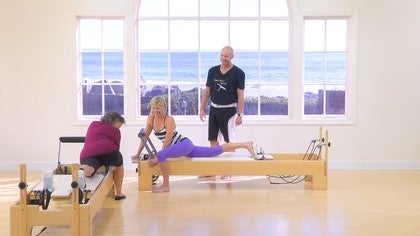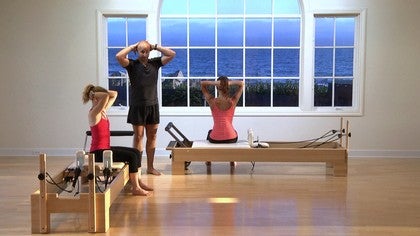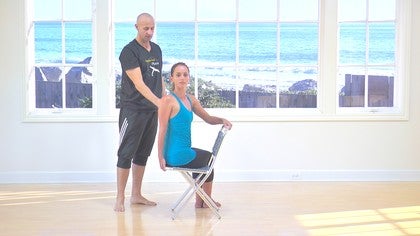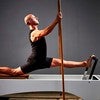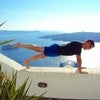Description
About This Video
Transcript
Read Full Transcript
Welcome everyone. I'm Anthony let from Australia. And what we're going to do in this segment is do some neck relaxation exercises. Um, the neck relaxation exercises or from a CD of the same name, and they're about integrating, stretching work into polarities. And those of you who've done a heavy Pilati session or feel tired at the end of the day might really benefit from loosening the neck and shoulders. Um, it's a great way to relax, a great way to way to get yourself to sleep as well. Um, and also a nice way to finish a class. So we're going to, um, try and stretch our neck in all of the ranges of movement.
So if you think about what movements your head is capable of, if you think about, for example, the four sides of the carriage here, or if you're at home sitting on a chair, you can flex your head forwards towards the front of the carriage. And then let's go back to neutral. You can tilt your head to one side or the other of a chair or a carriage and back to neutral. You can also tilt your head backwards to the back of the carriage and back to neutral. And you can also turn your head to one side or to the other.
So there are those basic movements of forward, backwards, sideways and turning. And then there's a couple of stretches at the end where we combined some of those things. So I'm going to get you to do, the stretch is very slowly because we're going to explore some variations within those movements. And if you've gone into things too hard, it'll be too difficult for you to hold them. So always stretch your neck very gently and slowly. Let's start off with bending our head to the side or what we call lateral flection. And what we need to do first is to position ourselves on if you're at home on a chair or sitting on a reformer so that you put your hand roughly in line with your hip. And when you lean to the side, what you need to make sure is that your bottom or your hip doesn't lift.
So just shift yourself away a little bit more, just slightly more. Meredith, if you can move over a bit so that as you lean to the side, your bottom won't lift and your shoulder will be drawn down, away from your ear. You could also be doing this on a [inaudible] box and with, if there are straps on the side, you can be holding onto one of the straps. So let's, let's, um, position the hand first and we'll start with your head in neutral and lean. First of all, lean away from your hand.
So I'm going to call this the restraining arm and very carefully take your head across towards the opposite shoulder. And then we're gonna reach the other hand up and over like this. And if possible, move your arm so that your head can you rest your head onto your arm so that the muscles can relax as much as possible. If you support the weight of your head, the muscles will be able to relax as much as possible and then spread your fingers so that they're positioned on the side of your head just around your ears, because you can pull on your skin a little bit with the fingers later on. So now you should be feeling a stretch down the side. You can see Meredith's muscles here being stretched. Um, so let, we've held that for about five breaths.
So now we're going to do a very gentle contraction. If you don't know what contract relax means, it's explained more fully in the beginners class that we have on PyLadies anytime. But now I'll just, um, proceed as if I as if you know what you're doing so lightly, press your head back into your fingers. So as if you pressing your head back towards the neutral position, but make sure that it doesn't move. So do that. Now. One, two, three, that's probably long enough for the neck muscles. Take a breath in, and then as you breathe out, lean a little further and then pull your head a little further over using your hand and your arm and just hold that stretch. Try and relax the arm that's holding onto the side of the reformer carriage or the chair. Try and let that go as loosely as you can. So you've led that, um, flop.
Now you can try just pulling gently on your skin with your fingers. Let your head drop onto your shoulders as much as you can. The more that you can relax, the greater the stretch you'll get. Now we're going to try a slight variation, which is to turn your face very slowly towards your armpit. So very slowly, nothing should be done quickly when you're stretching the neck and the stretch will move usually to the base of your skull rather than the side of your neck.
When you do that, let's hold it there. And now we're going to take your chin down towards your chest and roll your back to the center of your chest.
Now hopefully you should find that you have a slightly greater range of movement on that side. Do you both feel that too? Because when I come back next year, we will have time to stretch the other side. We might do it now. So let's turn around the other way and again, make sure that you position your hands so that it's in line with your hip and lean away slowly good. And you can see there as they both leaned away that the shoulder was drawn down, away from the ear. Then rates the other hand up and slowly take your head across.
So you resting your head on this arm and shoulder if you can, I mean just leaked your arm up a bit more so that your head can rest on it.
Take a breath in to raise stretch. First of all, lean a little further, very nice. And then pull your head across a little bit with your fingers. You can pull lightly on your skin using the fingers. And as I said on the other side, try and let this arm, even though you've got to use it to hold you in position, try and let it be as loose as possible. Now we're going to try that variation again.
So turn your face towards your armpit just very slowly. As soon as you feel a different stretch, then you can stop and hold that one. You have to be careful not to move through this too quickly. Otherwise you miss all the intermediate positions that can be so effective. And this is a good position for me to be able to show you where the stretch we started with stretch down the side of the neck and as you turn your head, it moves more towards this area here with the sub occipital muscles.
They're called down around the bottom of your skull. Now when you've had enough, let's very slowly roll your head back towards the center
What we might do is um, youth Meredith abuse day sitting this way so that everyone can say the back VNA and I'm, if you could turn around the front, then they get another perspective. So let's start off with um, take tucking your chin back towards your neck. Yup. As if you're holding a tennis ball underneath the chin there. And then put both hands, fingers together, both hands on the back of your head and gently pull up. As I'm doing, I'll just move over so you can see I'm pulling up on the back of my scalp.
Does. If you're pulling the back of your head up and you might feel that stretch again down the base of this, are you feeling it there? So round this area here at the base of the skull. Now we're going to try ash small contraction. So see if you can, again, not using much force. Imagine you're lifting your chin up towards the ceiling, so let's try that now. So one, two, three, relax. Take a breath in and then as you breathe out, see if you can pull up again on the back of the head. And now we're going to try taking the chin further down towards your chest. So again, to bend or at least straighten the hall of the back of the neck. Let's see if you can relax the arms.
You take as much of the weight of your arms onto your head as is comfortable. Don't force things. As you take the chin towards the chest, you probably notice the stretch moves further down some of those longer muscles that span this part of your spine.
This time we're going to turn our face towards our right. Bye. Good. I'll just, I'm going to come around this way, Meredith, so you can see what I'm doing. Turn your face towards the right thigh and then just pull a little more with the right hand. You should feel that more around this area. Yeah. Good.
Are you feeling what I'm talking about? I'll just move your hair out of the way. That's why I have mine this, this short, so I don't have this problem. Now let's turn the other direction. So now we're turning the face towards the left leg and then we're pulling the lift hand up the back of the head. So pulling on this part here.
You want to turn around so you can see it's a nice view, isn't it? Do you want me to turn? Yeah, perhaps if you turn around. Um, so now we've, we're now we're going to do, we've done lateral flection, we've done flection. Now we're going to do a bit of rotation, which means just turning to one side. So this time we'll put your hands this way. On your thighs just yet on the front there and slowly turn to the left.
There's thousands of small muscles in around the base of the head and neck that we're stretching here. So now you can roll slowly. Roll your head back towards the [inaudible] center. So take your head down there that that way. Yeah, so you can see that we're working very slowly here because the neck muscles and the arteries and so on are very delicate in the neck. So we have to make sure that you do things very carefully and very slowly. Let's turn to the other direction there.
So I think we're going to turn to the right. Draw your shoulders back again and how old. And now let's lift the right hand up and put it on your left cheek, the facial cheek. Now push your face gently back into your hand. One, two, three, stop.
Take a breath in and then as you breathe out, see if you can turn your face a little further towards your right shoulder. Tuck your Chin down.
Yeah. And where are those? Where are those ping pong balls now? So with your mouth open, take your head back slowly and then as you close your teeth, you should feel the stretch emerge down the front of the neck. Are you both feeling that? Yeah, it's very hard to talk your head back like that. Okay, so let's hold still. We went to any contractions. He will just hold that stretch. And what we can do though is we can very, very slowly turn your head or tilt it slightly to one side.
One of the muscle groups with stretching here are the scalene muscles, which are often quite tight. They're used a lot in breathing and the nerves that innovate our arm run through them. So things like pins and needles and thoracic outlet syndromes that we often experience can be the result of having tight muscles here. So turn your head the other way if you haven't already.
Um, we might do just one more stretch and um, for the muscles that run from the shoulder blade to the back of the head, which are often very tight, specially, uh, and tightness, sort of causes the shoulders to ride up like this. So let's just do that one before we finish. Let's, um, you can stay seated as you are, but put your hand behind you. You might need to move back a bit so that you can grab the back corner of the box or the carriage under here. And you only need to be holding one hand. So let's have your right hand, the bank, um, and then what we're going to do is lean directly away from that hand. So forward and across. Yeah, directly away from the hand that's behind you.
Then take your chin towards your chest, reach the other hand up and put it on the back of your head. Now gently take your chin towards your chest and then towards the opposite arm pit. So we're, we're taking our head away from the hand that's behind us. Yeah, if you lightly pushed back into the hand that's on the back of your head. So one, two, three. Then relax. Big breathing. As you breathe out, try and relax your shoulders.
Take Your Chin a little further towards your chest and a little bit more towards the armpit. Remember, we're moving to the armpit that is opposite the arm that's holding onto the carriage behind us. So to come out of the stretch, just release the arm with behind you. Take the chin down towards your chest and back to the Seda. All right, let's do the other side so you can, uh, if you can get your fingers under there, it's good. If you need to turn around, you can. Okay. There. All right, so again, the hands behind, so lean away from the hand. So you're leaning forward and across, away from the restraining hand.
Good, and that'll draw the shoulder down and I can see some of the neck muscles already starting to stretch there. Now take your chin down towards your chest, reach the other hand. Up goes a mirrored six. You take your chin down towards your chest and then do what Amy is doing, which is to pull your head towards the other armpit and hold. Try and keep sitting up tall if you can. So it's just the neck we're bending. Make sure every movement that you make here is very slow. Just focusing on your breathing and any sensations that are coming from the neck area. Relaxing the shoulders.
And now slowly push your head back into your hand. The hands it's on your head. One, two, three. Take a breath in. As you breathe out, lean a little further, take the chin towards the chest or just wave your head across a bit more murders that way. So your, your face is kind of hitting towards the opposite armpit. Yeah, that's probably long enough. So relax the arm that's behind you. Take Your Chin back towards the center of your chest and then again, slowly roll. You hit up a, lift your head up if you want to.
Good. Now, if you want to have a sleep, you can lie back down on the reforma. Okay. All right. Well thanks everyone. I hope you enjoy that stretch.
Feel the Length: Innovations in Pilates
Comments
You need to be a subscriber to post a comment.
Please Log In or Create an Account to start your free trial.
